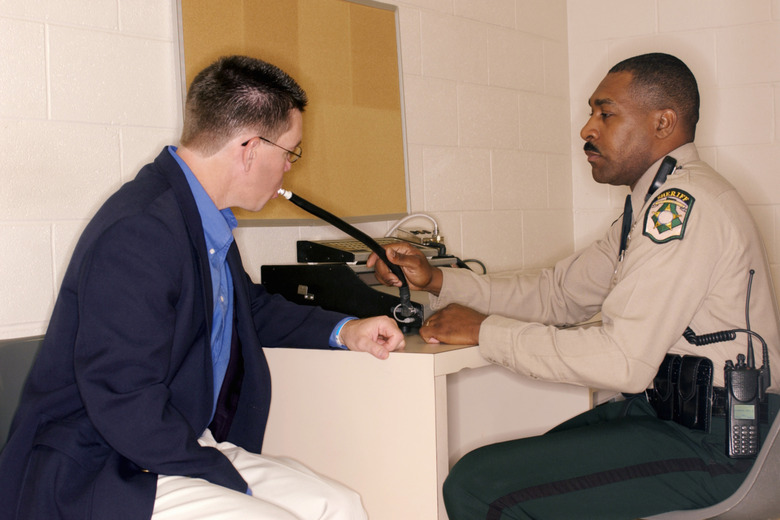How To Tell The Difference Between Alcohol & Alkene In Labs
An alcohol is a chemical with an -OH group, while an alkene is a chemical that contains two carbons double-bonded to each other. Each can participate in specific chemical reactions. Scientists can determine whether an unknown substance is an alcohol or an alkene by adding specific reagents and watching to see if a reaction takes place.
Baeyer's Test
Baeyer's Test
The first common chemical test for an alkene is called Baeyer's Test. It relies on a chemical called potassium permanganate, which reacts with alkenes to turn them into glycols, compounds with two alcohol groups attached to the two carbons that were previously double-bonded to each other. Potassium permanganate is bright purple in color, and as it reacts with the alkene the purple color disappears. If you add potassium permanganate to your unknown and the purple color disappears, it may be an alkene. The difficulty with this test, however, is that some alcohols can also react with potassium permanganate, so this is not entirely decisive.
Bromine Reaction
Bromine Reaction
Another common test is the addition of liquid bromine, which is brownish-purple in color. Bromine quickly reacts with alkenes to add a bromine atom to each one of the carbons on either side of the double bond. When you add bromine and water to a chemical and the color rapidly disappears, it may contain an alkene that is reacting with the bromine. This test is much more selective for alkenes than Baeyer's Test and therefore a better way to confirm your compound has a double bond.
Lucas Test
Lucas Test
The first of the many tests for alcohol is the Lucas test, whereby you add zinc chloride and concentrated hydrochloric acid to your compound. If it contains an alcohol attached to a carbon atom that has three other carbons bonded to it, known as a tertiary alcohol, a rapid reaction will produce a cloudy precipitate. A so-called secondary alcohol, attached to a carbon with two other carbons attached to it, reacts more slowly, producing a precipitate within five minutes or so. And alkenes, as well as primary alcohols wherein the alcohol group is attached to a carbon with only one other carbon bonded to it, do not react. This test is especially useful because it not only tells you whether you have an alcohol but gives you some idea of where the alcohol group may be located in the molecule.
Other Chemical Tests
Other Chemical Tests
Another common test for alcohols is to add chromic anhydride in sulfuric acid. This reagent reacts swiftly with primary and secondary alcohols, turning the solution green, but not at all with tertiary alcohols. Generally alcohols will be more water-soluble than alkenes, which is another useful way to distinguish them.
Infrared Spectroscopy
Infrared Spectroscopy
A more modern way to distinguish between alcohols and alkenes is with the use of infrared spectroscopy, whereby you use an instrument to shine infrared light through a sample and determine which wavelengths are absorbed. Alkenes feature absorption between 1680 and 1640 inverse centimeters, between 3100 and 3000 inverse centimeters and between 1000 and 650 inverse centimeters. Alcohols, by contrast, feature a broad and very characteristic absorption peak somewhere in the 3550-to-3200 range.
Cite This Article
MLA
Brennan, John. "How To Tell The Difference Between Alcohol & Alkene In Labs" sciencing.com, https://www.sciencing.com/tell-difference-between-alcohol-alkene-labs-15368/. 24 April 2017.
APA
Brennan, John. (2017, April 24). How To Tell The Difference Between Alcohol & Alkene In Labs. sciencing.com. Retrieved from https://www.sciencing.com/tell-difference-between-alcohol-alkene-labs-15368/
Chicago
Brennan, John. How To Tell The Difference Between Alcohol & Alkene In Labs last modified August 30, 2022. https://www.sciencing.com/tell-difference-between-alcohol-alkene-labs-15368/
